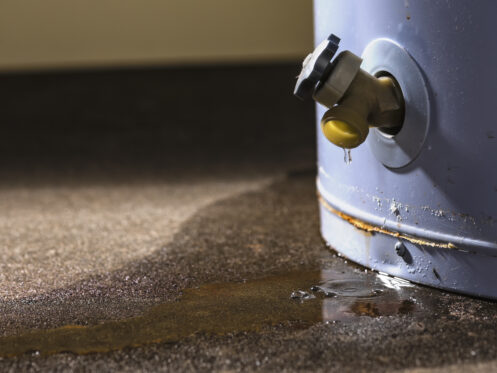Water heaters are indispensable appliances that provide hot water for various household tasks, ensuring our comfort and convenience. Like all mechanical systems, water heaters require regular maintenance to function optimally and have an extended life span. One crucial aspect of water heater maintenance is draining the tank periodically.
Why Draining a Water Heater Matters
Over time, sediment and minerals present in the water supply tend to settle at the bottom of the water heater’s tank and on interior components. This accumulation can lead to various issues and affect the efficiency of your water heater in the following ways.
Reduced Heating Efficiency
As sediment builds up at the bottom of the tank, it forms a layer that insulates the water from the heating element. This insulation effect hinders the transfer of heat to the water, resulting in increased energy consumption and longer heating times.
Increased Energy Consumption
A water heater struggling to heat water due to sediment buildup will draw more energy to reach the desired temperature, leading to higher utility bills.
Premature Wear and Tear
Sediment buildup causes the water heater to work harder, leading to increased wear and tear on its components. This can lead to more frequent repairs or even premature failure.
Rumbling or Popping Noises
Sediment buildup can create rumbling or popping noises as the water is heated. These noises are not only annoying but also indicative of a less efficient water heater.
How Often Should You Drain Your Water Heater?
The frequency of draining your water heater largely depends on the quality of your water supply and your household’s usage patterns. Several factors influence the rate of sediment buildup.
Water Hardness
If you live in an area with hard water that contains high levels of minerals like calcium and magnesium, sediment accumulation is more likely to be rapid. In such cases, it’s advisable to drain the water heater more frequently.
Usage Frequency
Households that use a large volume of hot water daily may experience faster sediment buildup compared to smaller households.
As a general rule of thumb, it’s recommended that you drain your water heater at least once per year. However, homes with hard water require more frequent draining. This process should take place once every six months in order to maintain optimal performance.
Steps to Draining Your Water Heater
Draining a water heater may seem like a daunting task, but with the right guidance, you can complete that task with ease. Follow these step-by-step instructions:
Turn Off the Power
Before beginning any maintenance, make sure your water heater is turned off. For electric water heaters, locate the circuit breaker connected to the unit and switch it off. For gas heaters, turn off the gas supply.
Allow the Water to Cool
To avoid potential burns, it’s essential to let the water cool down before draining the tank. For your safety, wait a few hours or even overnight to ensure the water is at a safe temperature.
Turn Off the Water Supply
Locate the water supply valve connected to the water heater and turn it off. This prevents new water from entering the tank while you’re in the process of draining it.
Attach a Garden Hose
Connect a garden hose to the drain valve located at the base of the water heater. Ensure the other end of the hose leads to a suitable drainage area, such as a floor drain or a nearby outdoor location.
Open the Pressure Relief Valve
To allow air to enter the tank and facilitate the smooth flow of water during draining, lift the pressure relief valve lever for a moment and then put it back down.
Start Draining the Tank
Open the drain valve and let the water flow out through the hose. Be cautious, as the water may still be hot. To gauge the progress, fill a bucket with the draining water and inspect it for sediment buildup.
Flush the Tank
If you notice a significant amount of sediment in the water that is draining out, consider flushing the tank. To do this, turn on the cold water supply for a few minutes while the drain valve is open. Flushing helps clear out more sediment from the tank.
Close the Drain Valve
Once the water runs clear and free of sediment, close the drain valve and disconnect the garden hose.
Turn on the Water Supply
Open the water supply valve and allow the tank to fill up again. To release any trapped air, keep a hot water faucet open in your home until a steady flow of water comes out. Once it’s steady, close the faucet.
Restore Power
For electric water heaters, turn the circuit breaker back on, and for gas heaters, turn the gas supply back on.
When to Seek Professional Assistance
While draining your water heater is a task that many homeowners can handle on their own, some situations may warrant professional assistance. If you’re unsure about the process, encounter complications, or notice signs of significant damage, it’s best to contact us at On Time Experts in Garland. Our team of skilled plumbers has the expertise and tools needed to address water heater issues efficiently and safely.
Here are some situations where professional help may be necessary:
Limited Experience
If you have little to no experience with plumbing maintenance, it’s best to leave this task to professionals to avoid potential mishaps.
Old or Damaged Water Heater
Older or damaged water heaters may have more complex issues that require professional assessment and repair.
Leakage or Rust
If you notice leaks or rust on your water heater, it’s essential to call in a professional. These issues can lead to severe damage and safety hazards.
Strange Noises
Unusual noises, such as banging or popping sounds, often indicate there are issues with your water heater. It should be inspected by a professional plumber.
Rely on Local Experts
As a leading plumbing service provider in Garland, On Time Experts takes pride in offering a wide range of solutions to meet the needs of homeowners. In addition to water heater maintenance and repairs, our comprehensive array of services includes plumbing inspections, water filtration installation, sewer line repair, bathroom and kitchen remodeling, and emergency plumbing repair. Plumbing emergencies can happen at any time, and we’re here to provide prompt and reliable emergency plumbing assistance. Besides that, we can handle all your needs regarding any sort of HVAC installation, repair, or maintenance. With our dedication to excellence and customer satisfaction, we stand out in the industry.
Draining your water heater is a crucial aspect of its maintenance, helping to remove sediment buildup and ensure its optimal performance. By following this step-by-step guide, you can accomplish this task efficiently and safely. However, for complex issues or if you feel unsure about the process, don’t hesitate to reach out to our team of professional plumbers at On Time Experts in Garland. With our expertise and dedication to providing top-notch services, you can have peace of mind knowing that your plumbing needs are in capable hands. Call us today.

